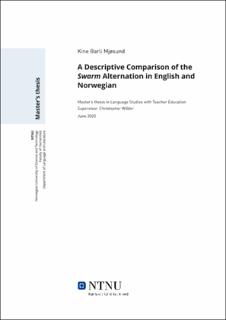| dc.description.abstract | In light of key properties discovered in the English swarm alternation, which over the years has been studied fairly thoroughly (e.g. Salkoff (1983); Levin (1993); Dowty (2000); Rowlands (2002)), this thesis primarily investigates what appear to be the hitherto not investigated Norwegian equivalents, in order to shed light on two things: (i) the nature of the phenomenon in Norwegian and (ii) English-Norwegian similarities and differences in this domain. The data largely comprise three types of sources: data presented in the relevant academic literature; attested natural data, found e.g. via Google search; and native speaker judgements on attested and constructed examples. Furthermore, since no work, to my knowledge, has previously been done on the swarm alternation in Norwegian, the research and theories of other linguistic scholars within the generative grammar approach, though especially Dowty (2000) and Levin (1993), are central as a point of departure for the investigation of similar aspect of the alternation in Norwegian.
The data examined shows that there are several English-Norwegian similarities as well as some notable difference regarding the swarm alternation. The alternation in both languages has a similar unmarked (A-subject) pattern with the ‘AGENT’ appearing in the subject position and the LOCATION appearing in a locative PP headed by in/on in English and i (in)/på (on) in Norwegian, and the (non-)alternating verbs/semantic classes of verbs also appear to be the same. Furthermore, what is argued to be a SwarmAlt signature property (‘AGENT’ realised in a with- / av/med-PP with special restrictions) is also established for both English and Norwegian SwarmAlt. There are, however, some notable English-Norwegian differences. Norwegian SwarmAlt contains a marked variant in an impersonal (det-subject) pattern in addition to a somewhat more restricted L-subject pattern which is similar to English, sometimes giving rise to a three-way alternation. A second major difference relates to how Norwegian SwarmAlt involves a type with directional PPs (directed motion verbs), and although English SwarmAlt also has motion verb type, it is much more restricted. However, the deeper questions that arise from the discussion are not easily answered within the scope of this master’s thesis. I am therefore hoping that the work I have done in this thesis will be helpful to future linguists conducting further research on the swarm alternation (in English and Norwegian). | |
